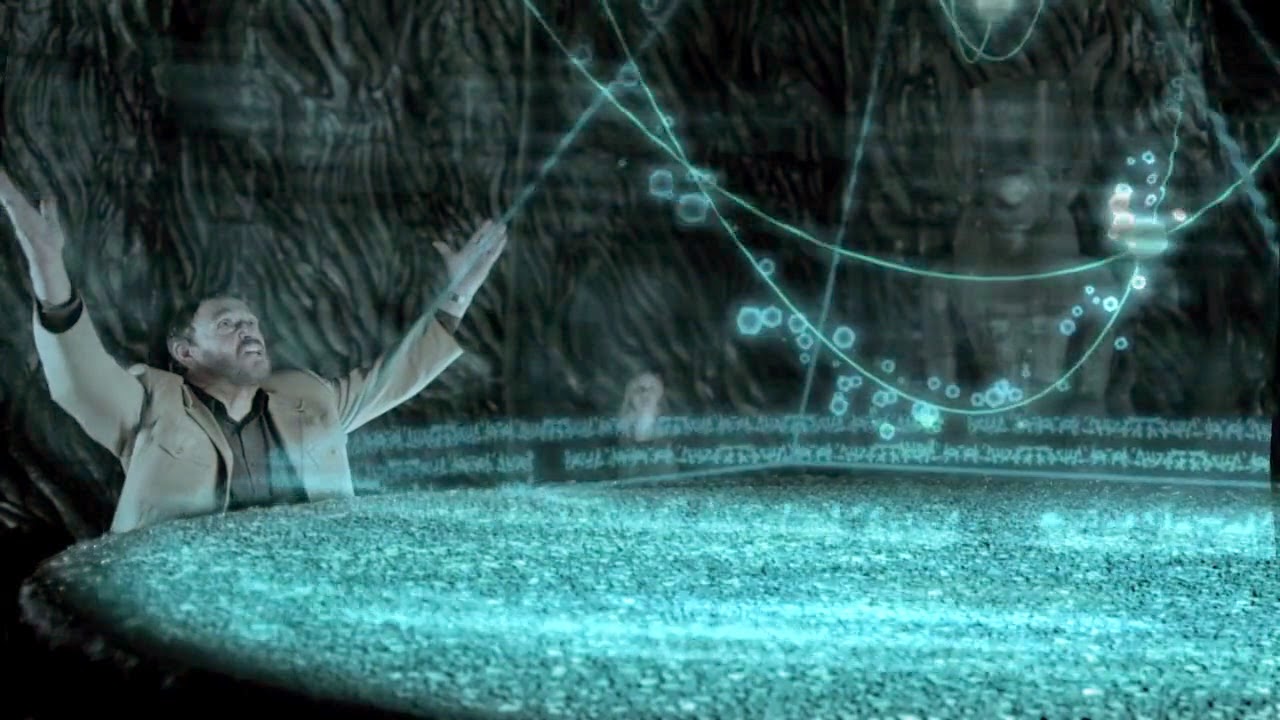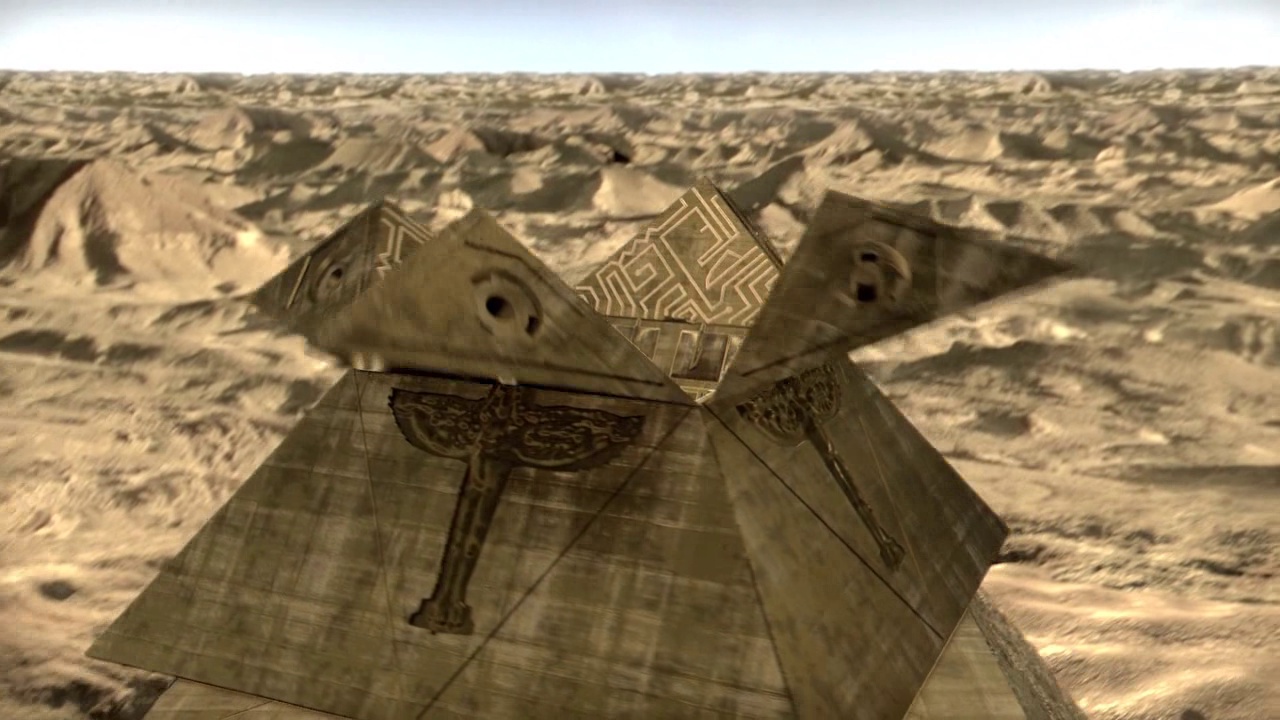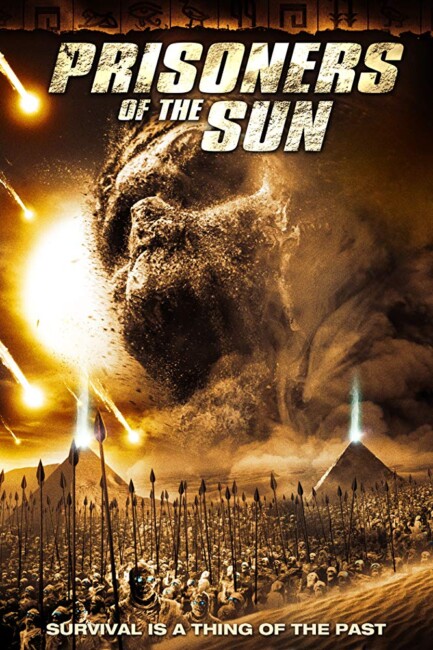Germany. 2013.
Crew
Director – Roger Christian, Screenplay – Peter Atkins & Anthony Hickox, Producers – Alexander Dannenberg, Neil Dunn, Peter Heizmann, Harald Reichebner & Peter Schulz, Photography – Ed Wild, Music – Maarten Buning, Visual Effects Supervisors – Sacha Bertran, Alan Church, Jan Fees & Simon Giles, Visual Effects – LUXX Studios (Supervisors – Andrea Block & Christian Haas), Special Effects Supervisors – Alan Church, Bob Keen & Alastair Vardy, Makeup Effects Design – Bob Keen, Production Design – Luca Tranchino. Production Company – MEC Productions/LUXX Film/Cinemakers.
Cast
John Rhys-Davies (Professor Hayden Masterton), David Charvet (Dr Doug Adler), Carmen Chaplin (Sarah Masterton/Princess Amanphur), Joss Ackland (Professor Mendella), Michael Higgs (Peter Levitz), Gulshan Grover (Rohit), Emily Holmes (Claire Becket), Nick Moran (Adam Prime), Shane Richie (Kalfhani), Edy Arellano (Sahid), Katherine Heath (Jemila), Isabella Orlowska (Heather)
Plot
In Ancient Egypt, the Pharaoh manages to imprison the alien Osiris inside a tomb and buries them there, building the pyramid of the Princess Amanphur over the site. Five thousand years later in present-day Egypt, Professor Hayden Masterton is overseeing a dig to find Amanphur’s tomb. He is eager to do so in time for the upcoming planetary alignment, hoping that this will reveal the secrets of the Osiris. The ruthless treasure hunter Peter Levitz murders to obtain The Key to Time that will open the pyramid. He then leaves evidence that blames Masterton in order to blackmail him into joining the expedition. A freak storm uncovers the pyramid and the party are able to enter. However, once inside, they find themselves up against revived mummies, traps created to keep out interlopers and the mysteries of the Osiris.
Quite some time ago, I celebrated the name of Roger Christian on the basis of his first directorial outing, an excellent little-seen psychic powers film The Sender (1982). Christian had previously been a set dresser, graduating to art director with such notable credits as Star Wars (1977), Alien (1979) and Monty Python’s The Life of Brian (1979). He plodded away over the next two decades making a handful of films with the likes of the planetary adventure Starship/Lorca and the Outlaws (1984) and Nostradamus (1994), a biopic of the supposed clairvoyant, as well as the non-genre thrillers The Final Cut (1996), Underworld (1996) and Masterminds (1997), all of which gained little notice. Then came the film that Christian’s name shall be forever associated with – alas, not in a good way – the disastrous flop of Battlefield Earth: A Saga of the Year 3000 (2000). It took Christian a long time to come back from that – he did not return to genre material until Stranded (2013), which proved to be an embarrassingly slipshod alien infection film and did nothing to raise his profile.
Prisoners of the Sun – not to be confused with the Tintin comic-book Prisoners of the Sun (1949), which takes Tintin, Captain Haddock et al on an adventure among the Incas – finally emerges, having been shot way back in 2006 and having sat on the shelves for seven years. Christian has some interesting names on the credits with him. The script comes from Peter Atkins, the writer of several Hellraiser sequels, Fist of the North Star (1995) and Wishmaster (1997), and Anthony Hickox, better known as a director of genre films such as Waxwork (1988), Sundown: The Vampire in Retreat (1989) and Hellraiser III: Hell on Earth (1992), among others.
One of the producers is Uwe Boll, the loudly proclaimed world’s worst director, responsible for the likes of House of the Dead (2003), Alone in the Dark (2005), Bloodrayne (2005) et al, which may well say something about how far down Roger Christian’s career has sunk post Battlefield Earth. To Roger Christian’s credit, Prisoners of the Sun gives the impression that it has an effects budget that is at least thirty times larger than the one he was operating with on Stranded.

Roger Christian and co have delivered what would be a serviceable copy of Raiders of the Lost Ark (1981) if it were say delivered around 1983. (From the timing, you can see it was probably intended as a copy of Indiana Jones and the Kingdom of the Crystal Skull (2008), which involved both a very similar mixture of tomb raiding and Ancient Astronauts). The Raiders parallels are fairly obvious – the chief archaeologist here is played by John Rhys-Davies who played a supporting role in Raiders, while there is a line that nods in the direction of obvious inspiration at one point: “You know Hitler tried to send archaeologists to find it.”
The first 40 or so minutes of the film are involved with the various skulkings, betrayals and in-politicking as the party comes together. The rest of the film, once it gets us inside the pyramid, becomes a staggeringly ordinary adventure film. After this point, Prisoners of the Sun follows all the tomb raider cliches – the fiendish death traps set to repel all trespassers, the secret doors, the puzzles that need to be unlocked, the treacherous member of the party who endangers everybody with their greed and so on. All of these feel so tired and creaky that the film fails to generate any suspense The film even drags out the creaky cliche of heroine Carmen Chaplin being the direct descendant (or more commonly in these films, the reincarnation) of the original princess.
Within the opening scenes, we get an introduction that interprets Ancient Egyptian mythology in terms of visiting aliens. This is an old idea that was suggested by crackpot writer Erich von Daniken in his book Chariots of the Gods (1968) and numerous follow-ups. Von Daniken’s idea of Ancient Astronauts has bled through into a surprising number of science-fiction films with the likes of Starship Invasions (1977), the original Battlestar Galactica (1978-9), Hangar 18 (1980), The Pumaman (1980), Sky Bandits/Sky Pirates (1985), Stargate (1994), AVP: Alien vs. Predator (2004), 10,000 BC (2008), Indiana Jones and the Kingdom of the Crystal Skull, The Fourth Kind (2009), Stonehenge Apocalypse (2010), Killer Mountain (2011), Prometheus (2012) and Phoenix Forgotten (2017), as well as the documentary Chariots of the Gods (1970). (For more detail see Films About Ancient Astronauts).

The biggest disappointment of the film is its utter letdown on its promise. The film is constructed around the build-up to the discovery of the alien Osiris at the heart of the pyramid. What little interest there is comes in waiting to see what the adventurers find when they arrive there. The big disappointment is that when we do get there, the film only briefly awakens the aliens – we don’t even get to see what they look like – before the is blown pyramid up and comes crashing down around everybody as they narrowly make their way out. The film ends with vastly underwhelming effect (and the hint of a sequel) as the survivors look up at the sky and comment: “We know they’re out there.’
John Rhys-Davies bluffs and barnstorms his way through another overwrought performance. Doing most of the adventuring work is the younger David Charvet who gives the impression he was cast solely for his pretty boy looks and does little to indicate he is taking the show seriously. At least Carmen Chaplin, Charlie’s granddaughter, holds her own in a seriously intent showing as the lead actress.
Trailer here


